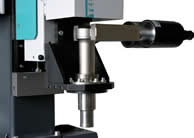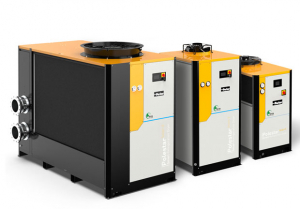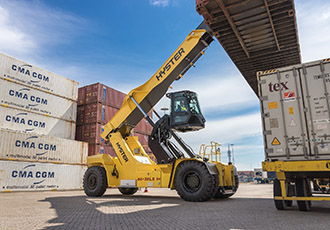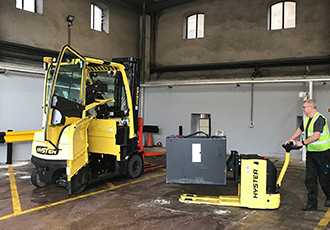Telsonic put a twist on ultrasonic welding for medical and electronic components
17th April 2009
Source:
Telsonic UK Limited

The use of ultrasonics as a process for welding, joining and sealing has been widespread within industries such as plastics and automotive for many years. The characteristics of the conventional process, which produces amplitude in the vertical plane, has until now however limited the use of the technology for certain applications within the electronics or medical device industries. This has been largely due to concerns over possible damage to fragile electronic components or perforation of micron thin seals and membranes. The new Soniqtwist® technique developed by Telsonic in Switzerland eliminates these problems using small circumferential amplitudes, and allows even the most delicate electronic components and membranes to be joined, welded or sealed using this pioneering process.
Membrane welding made possible using the Soniqtwist technique
Thin films and membranes, which have a typical thickness of only 50µm, are used to create a hermetic air tight seal on medical pots, devices, containers and drug delivery systems. It is essential therefore that any process used to weld the delicate film or membrane media does not induce any defects or damage.
The vertical amplitudes produced across the face of a sonotrode or horn, when using conventional ultrasonic welding techniques, causes a diaphragm effect when welding a thin film or membrane. This in turn may result in perforation of the membrane, effectively rendering the conventional ultrasonic welding process unsuitable for this type of application.
Soniqtwist® however, produces small amplitudes of typically 60µm pp in a circumferential manner at the perimeter of the seal, with the torsional amplitude diminishing to almost zero at the centre of the membrane or film. Soniqtwist® does not stretch the membrane during welding nor does it cause a diaphragm effect or induce perforation of the film. The Soniqtwist® technique therefore effectively eliminates the risk of perforation, when welding polymer based foils, films & membranes. The technique also has the advantage of speed, with complete weld cycles being achieved in less than 1 second. The unique characteristics of Soniqtwist® also enables multiple membranes, in close proximity to one another, to be processed without causing any previously welded membrane to become dislodged or lose its hermetic seal, a concept not possible using conventional ultrasonic welding techniques.
The characteristics of Soniqtwistt® make it the ideal process for a wide range of welding and forming operations on thin wall section components in a variety of materials, including plastics, ceramic and aluminium. The process also minimises particle production and size, supporting good automated manufacturing practice requirements in the medical device manufacturing sector. The benefits of Soniqtwistt® can also be applied to welding operations on housings which contain delicate electronic devices which must not be damaged or affected during welding. The process is not limited to circular parts, with rectangular and non symmetrical shaped components capable of being welded, sealed and joined using this technique
Soniqtwist® - a unique principle
Conventional ultrasonics has the converter, operating at between 20kHz and 35kHz, mounted on top of a booster to increase the amplitude. The sonotrode or horn is in turn coupled to the booster, which utilises the lower cross sectional area of the sonotrode working face to magnify this amplitude still further. By using a pneumatic actuator in conjunction with the energy being delivered via the sonotrode, the process creates local heat and melt. The vertical force from the pneumatic actuator force collapses the molten joint and holds it in position until the weld joint has solidified.
Telsonic engineers have designed the Soniqtwist® welding head such that it can be easily retrofitted to a standard bench top machine . The head can also be mounted to pneumatic actuator modules or servo operated actuators, enabling incorporation within a fully automated assembly machine. The Soniqtwist® configuration can also be used in multi-head applications, an area within which Telsonic excels with extensive application experience.
The Soniqtwist® principle is quite different as the converter is mounted tangentially to the booster axis thus creating reciprocal circumferential amplitude to the specially designed sonotrode. The Soniqtwist® process creates a reciprocating ultrasonic friction weld of the upper contacted film, membrane or rigid part component about the lower component part. The vertical force, from the electronic proportionally controlled pneumatic actuator used in the Soniqtwist® configuration, collapses the molten joint and maintains the required pressure until the weld joint has solidified.
Telsonic engineers have designed the Soniqtwist® welding head such that it can be easily retrofitted to a standard bench top machine . The head can also be mounted to pneumatic actuator modules or servo operated actuators, enabling incorporation within a fully automated assembly machine. The Soniqtwist® configuration can also be used in multi-head applications, an area within which Telsonic excels with extensive application experience. With the medical sector already an important area of activity for Telsonic, with many ultrasonic welding systems operating in relevant industry clean room class environments, the introduction of Soniqtwist® will open up a broad range of new application areas for both the technology and the company.
Thin films and membranes, which have a typical thickness of only 50µm, are used to create a hermetic air tight seal on medical pots, devices, containers and drug delivery systems. It is essential therefore that any process used to weld the delicate film or membrane media does not induce any defects or damage.
The vertical amplitudes produced across the face of a sonotrode or horn, when using conventional ultrasonic welding techniques, causes a diaphragm effect when welding a thin film or membrane. This in turn may result in perforation of the membrane, effectively rendering the conventional ultrasonic welding process unsuitable for this type of application.
Soniqtwist® however, produces small amplitudes of typically 60µm pp in a circumferential manner at the perimeter of the seal, with the torsional amplitude diminishing to almost zero at the centre of the membrane or film. Soniqtwist® does not stretch the membrane during welding nor does it cause a diaphragm effect or induce perforation of the film. The Soniqtwist® technique therefore effectively eliminates the risk of perforation, when welding polymer based foils, films & membranes. The technique also has the advantage of speed, with complete weld cycles being achieved in less than 1 second. The unique characteristics of Soniqtwist® also enables multiple membranes, in close proximity to one another, to be processed without causing any previously welded membrane to become dislodged or lose its hermetic seal, a concept not possible using conventional ultrasonic welding techniques.
The characteristics of Soniqtwistt® make it the ideal process for a wide range of welding and forming operations on thin wall section components in a variety of materials, including plastics, ceramic and aluminium. The process also minimises particle production and size, supporting good automated manufacturing practice requirements in the medical device manufacturing sector. The benefits of Soniqtwistt® can also be applied to welding operations on housings which contain delicate electronic devices which must not be damaged or affected during welding. The process is not limited to circular parts, with rectangular and non symmetrical shaped components capable of being welded, sealed and joined using this technique
Soniqtwist® - a unique principle
Conventional ultrasonics has the converter, operating at between 20kHz and 35kHz, mounted on top of a booster to increase the amplitude. The sonotrode or horn is in turn coupled to the booster, which utilises the lower cross sectional area of the sonotrode working face to magnify this amplitude still further. By using a pneumatic actuator in conjunction with the energy being delivered via the sonotrode, the process creates local heat and melt. The vertical force from the pneumatic actuator force collapses the molten joint and holds it in position until the weld joint has solidified.
Telsonic engineers have designed the Soniqtwist® welding head such that it can be easily retrofitted to a standard bench top machine . The head can also be mounted to pneumatic actuator modules or servo operated actuators, enabling incorporation within a fully automated assembly machine. The Soniqtwist® configuration can also be used in multi-head applications, an area within which Telsonic excels with extensive application experience.
The Soniqtwist® principle is quite different as the converter is mounted tangentially to the booster axis thus creating reciprocal circumferential amplitude to the specially designed sonotrode. The Soniqtwist® process creates a reciprocating ultrasonic friction weld of the upper contacted film, membrane or rigid part component about the lower component part. The vertical force, from the electronic proportionally controlled pneumatic actuator used in the Soniqtwist® configuration, collapses the molten joint and maintains the required pressure until the weld joint has solidified.
Telsonic engineers have designed the Soniqtwist® welding head such that it can be easily retrofitted to a standard bench top machine . The head can also be mounted to pneumatic actuator modules or servo operated actuators, enabling incorporation within a fully automated assembly machine. The Soniqtwist® configuration can also be used in multi-head applications, an area within which Telsonic excels with extensive application experience. With the medical sector already an important area of activity for Telsonic, with many ultrasonic welding systems operating in relevant industry clean room class environments, the introduction of Soniqtwist® will open up a broad range of new application areas for both the technology and the company.
Similar articles
More from Telsonic UK Limited
- Telsonic Showcase New Ultrasonic Packaging Technology at Total Processing & Packaging 2010 11th March 2010
- Telsonic UK Limited to Showcase New Technologies and Concepts at PDM 2010 11th March 2010
- Ultrasonic Welding - Design for Successful Production 7th March 2010
- Telsonic Keep Ultrasonics Safe and Sound 2nd December 2009




.jpg)







Write a comment
No comments